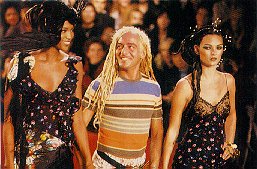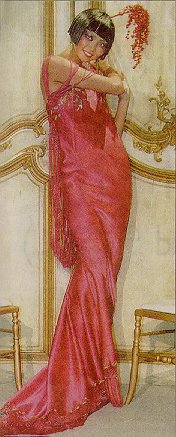
Return to 1997 SPRING Index
![]()
A New Look
By Anita Hunter
1997 is a landmark year for the House of Dior. It is 50 years since Christian Dior introduced the revolutionary 'New Look' and it also marks John Galliano's first collection as design director. Will Galliano be able to revitalise this haute couture house and give it a new look for the future?
Christian Dior only achieved fame as a fashion designer in middle age. Born in 1905 he abandoned his early training in political science and taught himself to draw. He started his fashion career selling drawings to couture houses and magazines and then trained formally with Robert Piquet and Lucien Lelong. In 1946, The House of Dior was launched with the financial and business backing of French textile manufacturer Marcel Boussac.

The New Look
The first Dior collection shown in February 1947 was a spectacular success. Called the 'Carolle Line,' but christened 'The New Look' by American journalists. It was a complete contrast to the austere utility fashions that had prevailed during and after the Second World War. Narrow shoulders, exaggerated breasts, cinched waists and huge skirts brought back femininity and glamour. Public demand was instantaneous and 'The New Look,' quickly became a post-war symbol of 'Youth, Hope and the Future.'
The New Look established Dior's reputation and was instrumental in reviving the fortunes of the French couture industry. During the next ten years, he developed the theme of the New Look and went on to produce more sophisticated lines and shapes. The introduction of the Princess Line, the 'A' line and the 'Y' line confirmed his reputation.
Innovation and meticulous craftsmanship established the house of Dior as one of Paris' top couture houses. At the time of his death in 1957, Dior was the head of a multi-million pound organisation responsible for nearly 50% of France's fashion exports. As well as selling couture, the house of Dior had been shrewd enough to recognise the potential of business in fashion. The general manager Jacques Rouet had organised licence and merchandising agreements to manufacture ready to wear, jewellery and accessories. Parfums Christian Dior had also successfully launched the fragrances Miss Dior, Diorama and Diorissima.
Yves Saint Laurent joined Dior in 1955 and took control of design following the sudden death of his mentor in 1957. His 1958 'Trapeze line' was a great success but subsequent collections were less well received. His 1960 collection based on the Bohemian, left bank look was panned by the critics. In the same year, St Laurent was conscripted into the French army to fight in the Algerian war. The house of Dior used this as an opportunity to replace him with Marc Bohan. Saint Laurent successfully sued Dior for breach of contract and went on to open his own house in 1962.
Marc Bohan was head designer and art director at the house of Dior from 1960 to 1989. Bohan combined modernity with classic styles and shapes to produce wearable, elegant clothes. New styles and shapes were gently introduced to his loyal clientele who valued the flattering luxury of his clothes. Although Bohan's couture work was successful, he failed to produce a popular ready to wear line and this ultimately led to his departure from the company.
During Bohan's tenure there were enormous upheavals. Parfums Christian Dior was sold off in the late 1960s. In 1978, Marcel Boussac's companies (including Dior) went into liquidation. Dior was bought by the Agache-Willot group. Agache-Willot in turn hit the wall in 1981. Dior and the other Agache-Willot companies were purchased by Bernard Arnault who went on to acquire a whole stable of luxury goods companies, including Louis Vuitton, Moet & Chandon, Hennessy and Parfums Christian Dior.
Bohan moved to Norman Hartnell in 1989 and was replaced by the Italian designer, Gianfranco Ferre. His brief for Dior was to supply the house with an image for the nineties. Ferre originally trained as an architect and his work often bears reference to this in its precision and dramatic proportions. Although elegant and eminently wearable, his collections contained few references to Dior's illustrious past. Neither were they sufficiently innovative to revive the fortunes of the house of Dior.

Following much hype and newspaper speculation, the maverick British designer John Galliano took over the reins at Dior in 1996. Galliano graduated from St Martins School of Art in 1983 and has gained an international reputation for avant-garde designs and skilful cutting.

His first Dior show in January 1997 was a theatrical event. Eccentric and bizarre outfits grabbed newspaper headlines but as Clinton Silver of the British Fashion Council pointed out "Look through the hype and theatrics and you will see fabrics cut and draped professionally and effortlessly - pure skill". Beneath Maori breast plates and extravagant hats were wasp waisted jackets, bias cut dresses and exquisitely cut lace, chiffon and tulle. Galliano had raided the Dior archives to produce updated versions of Dior classics. "I have tried to imagine what Monsieur Dior would have done if he were alive in the 1990's". Carl Lagerfeld successfully used this formula to re-invigorate Chanel. Chanel's signature tweed suits and gilt buttons have been retained but each season they are reworked to produce a collection that is witty and innovative but still retains the spirit of Coco Chanel. Can Galliano use this formula to inject Dior with new life and revive its flagging fortunes.
The collection was greeted with a mixed reaction. Press and buyers were worried that traditional customers would reject Galliano's cutting edge designs. But it may be that the house of Dior is looking to appeal to a newer, younger customer.
Even if the couture collection is not a huge commercial success, the media coverage represents millions of pounds worth of free publicity for the Dior name. This in turn is likely to generate sales of the high profit items such as perfume and make up. Couture, although prestigious, is often a loss making activity that provides publicity to and is in turn subsidised by licences and ready to wear lines.
Yves St Laurent spoke out after the show complaining that, "Fashion is following a very dangerous course. Galliano has been hired by people who want to sell perfumes and licences, instead of fashions. They don't sell clothes anymore." Galliano has undoubtedly been brought in to increase the profitability of the house of Dior. But St Laurent has chosen to ignore his undoubted skills as a designer. Exploiting the prestige of couture collections through licences is hardly new or shocking. Designers may wish to be artists but ultimately, most are slaves to commerce. John Galliano may be the new design director at Dior but he remains an employee.
Christian Dior was undoubtedly one of the most important and innovative designers of the 20th Century. He made Dior the most famous fashion house in the world. it remains to be seen if Galliano has the ability to bring back the prestige and pre-eminence of the house of Dior.
![]()